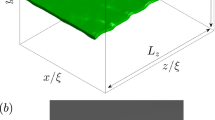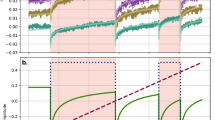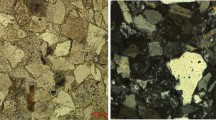Abstract
THE study of fracture is an old topic1, but only recently has an understanding begun to emerge of crack formation, propagation and morphology (which is often fractal) 2–8. When a brittle material such as glass is broken under tensile stress9, the cracks have a complicated morphology10. Fineberg et al.11 showed that this process may be caused by a dynamic instability, whereby the speed of crack propagation increases until it approaches the speed of sound: at this point, complex structures appear. But crack morphology in quasistatic fracture, where the speed of the crack tip is much smaller than the speed of sound, can also exhibit marked changes12. Here we present studies of crack propagation in glass plates caused by sudden but carefully controlled cooling. We observe a transition from straight to regular, wavy cracks as the tip speed increases. The scaling behaviour of an appropriately defined relaxation time suggests that this transition is a Hopf bifurcation13, like those seen in a variety of other nonlinear systems. At still higher speeds, the oscillatory cracks split into first two and then four or more branches.
This is a preview of subscription content, access via your institution
Access options
Subscribe to this journal
Receive 51 print issues and online access
$199.00 per year
only $3.90 per issue
Buy this article
- Purchase on SpringerLink
- Instant access to full article PDF
Prices may be subject to local taxes which are calculated during checkout
Similar content being viewed by others
References
Griffith, A. A. Phil. Trans. R. Soc. A221, 163–198 (1920).
Herrmann, H. J. & Roux, S. (eds) Statistical Models for the Fracture of Disordering Media (North-Holland, Amsterdam, 1990).
Charmet, J. C., Roux, S. & Guyon, E. (eds) Disorder and Fracture (Plenum, New York, 1990).
Mandelbrot, B. B. & Paullay, D. E. Nature 308, 721–722 (1984).
Takayasu, H. Prog. theor. Phys. 74, 1343–1345 (1985).
Skjeltop, A. T. & Meakin, P. Nature 335, 424–426 (1988).
Herrmann, H. J., Kertesz, J. & de Arcangelis, L. Europhys. Lett. 10, 147–152 (1989).
Mori, Y., Kaneko, K. & Wadachi, M., J. phys. Soc. Japan, 60, 1591–1599 (1991).
Yoffe, E. H. Phil. Mag. 42, 739–750 (1951).
Ravi-Chandar, K. & Knauss, W. G. Int. J. Fracture 25, 247–252 (1984); 26, 65–80 (1984); 26, 141–154 (1984); 26, 189–200 (1984).
Fineberg, J., Gross, S. P., Marder, M. & Swinney, H. L. Phys. Rev. Lett. 67, 457–460 (1991).
Hirata, M. Scient. Pap. Inst. phys. chem. Res. (Japan) 16, 172–195 (1931).
Guckenheimer, J. & Holmes, P. Nonlinear Oscillations and Bifurcation of Vector Fields (Springer. Berlin. 1983).
Stevels, J. M. in Handbuch der Physik Vol. 13 (ed. Flugge, S.) (Springer, Berlin, 1962).
Author information
Authors and Affiliations
Rights and permissions
About this article
Cite this article
Yuse, A., Sano, M. Transition between crack patterns in quenched glass plates. Nature 362, 329–331 (1993). https://doi.org/10.1038/362329a0
Received:
Accepted:
Published:
Issue date:
DOI: https://doi.org/10.1038/362329a0
This article is cited by
-
A Review of Benchmark Experiments for the Validation of Peridynamics Models
Journal of Peridynamics and Nonlocal Modeling (2019)
-
Imaging Slit Pores Under Delaminated Splats by White Light Interference
Journal of Thermal Spray Technology (2018)
-
Universality of periodicity as revealed from interlayer-mediated cracks
Scientific Reports (2017)
-
Fracture in sheets draped on curved surfaces
Nature Materials (2017)
-
The Breakage of Float Glass with Four-Edge Shading Under the Combined Effect of Wind Loading and Thermal Loading
Fire Technology (2017)



